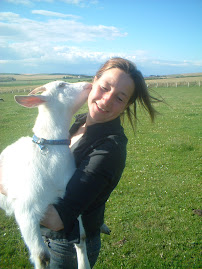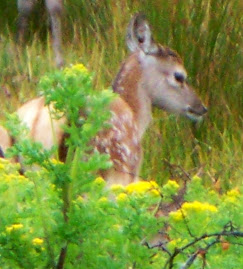Tuesday, 30 April 2013
Ostriches and Drambuie
Saturday, 20 April 2013
A Very Special Cat
Saturday, 6 April 2013
A Moment of Madness...
Friday, 5 April 2013
Wednesday, 3 April 2013
Sunday, 23 August 2009

I was having a busy morning- it was a cold, wet and windy March day and the winter feeding regime was still in full swing. Hay for the ponies, barley, beet and hay for the cattle, ewe rolls and hay to the ewes (most of whom had lambed). There were also the year-round morning jobs – milking the goats, feeding them hay and concentrates, grain for the chickens, geese and ducks, and cats and dogs to be fed. My big treat after this is to make myself a flask of hot coffee, call the dogs, who know my routine backwards, being acute observers of my every action. When I go into the kitchen to cut a slice of bread for the ducks, they know that when I return it will be time to spring into action – racing towards the door, slipping and sliding and hurling themselves at full pelt towards the path to the woods. Then Mac, the red and white collie will suddenly remember that he needs his toy and will race to his secret stash and pick out a toy of the day. I do a quick checklist: two dogs, one toy, flask of hot coffee and a pocket full of peanuts for the bird feeder in the woods, and off we go…
As we walk up the hill along the side of the fields I cast an eye over the beasts in the field to make sure all are feeding and behaving normally. This particular day it was nearly normal, but not quite…All the animals were munching away, except the sheep, who always beg for hay then treat it with casual disdain after taking a few mouthfuls, preferring to search in vain for signs of new spring grass. I couldn’t quite put my finger on what was not right, and was distracted from this train of thought by a gentle tap on my knee – Mac was reminding me that I needed to throw his toy for him, I refilled the bird feeder and, like the animals, searched in vain for signs of spring – no swelling buds on the trees, no singing birds, and even the daffodils seemed reluctant to show any enthusiasm.
On our return I set about filling the water troughs, thankful that at least the rainy night meant that I wouldn’t have to defrost the hose – one of my least favourite jobs in the winter. As I was going about I noticed that both ponies were standing by the fence which divides their paddock from the sheep field. They were pricking their ears at something next door – if net curtains had been involved they would certainly have been twitching. Thinking that they were coveting the hay left behind by the discerning sheep I didn’t take too much notice. About an hour later, by now soaked by the persistent rain, I looked across and saw that the ponies were still showing an interest in the sheep field and I decided that this merited further investigation. All of the sheep were grazing at the top of the field, and about fifty yards away, in a dip in the ground; a small black shape was flailing around in the mud. As I walked towards it I realised that it was a newborn lamb – but where was mum? All the ewes were pointedly ignoring it, and I quickly checked them for signs of having lambed. I found one; she was hungrily munching grass while looking slyly at me out of the corner of her eyes. I picked up the lamb and walked towards her. She ran as fast as she could in the opposite direction. The poor wee lamb was soaking wet, covered in mud and crying plaintively for its’ feckless mum. I decided that action was needed to ensure it’s future, thinking back to the uneasy feeling I had had during the walk up to the woods I realised that it had been born a couple of hours earlier. I was reluctant to take the lamb away from its mother and reducing the chance of bonding, but that wasn’t about to happen at the moment anyway.
I had been waiting three years to put the Rayburn to its’ proper use, dreamt of while living in a small house in London with a clinical white kitchen and gas cooker. The only real point of having a Rayburn was its’ legendary ability to revive hypothermic lambs. The dogs obligingly moved over (probably because of shock at suddenly finding this alien creature in their midst) while I prepared The Full Works for the lamb – towel and hairdryer, ‘Kick Start’- a mixture of molasses and vitamins-, penicillin, iodine and a bottle of colostrum. After all that he refused to obligingly curl up next to the heat, scrambling onto his feet, long bendy legs seeming to go in four different directions at once, determined to follow me everywhere.
Storm, as we called him, never did manage to get a feed from mum, so he was hand reared with two rejected goat kids, and is doing very well as an honorary goat. He never did forget the comforts of the kitchen, and on occasion, when the door has been left open, he has been found cuddling up to the Rayburn with the dogs, quite at home…
Monday, 3 August 2009
Duck soup

I had discovered the two lost dogs on the road outside, after going and investigating the sound of cars screeching to a halt outside – fearing that one of our animals had somehow got out on the road. I didn’t recognise the excited and friendly dogs criss-crossing the road, panting heavily with tongues flapping out of open mouths. They were evidently having an adventure. They had collars but no identity tags, and concerned that an accident would happen, I decided to put them in our barn while I telephoned neighbours to se if they knew where the dogs were from. I had no luck and it was when I returned to check on them that I saw with horror that they had jumped out of the stall, squeezed through the side of a large sliding door which was closed but not locked, and started causing the havoc. One of the dogs was whirling around the edge of the pond in excitement, watching its companion hunting. Chickens, ducks and geese were scarpering in all directions and it took me a couple of seconds to recognise the limp filthy shape in the swimming dog’s mouth as Nick the drake.
I leapt into the pond (fortunately not very deep) shouting at the top of my voice, hoping that this might shock the dog into dropping its prey. This did not work so I gave chase. I don’t know if you’ve ever tried to chase something in a pond while wearing welly boots – but it is not easy. It’s a bit like one of those nightmares when you are trying to run away from something but can only move very slowly. The
I then telephoned the dog warden. Fortunately she was in the area and picked up the dogs within the hour. I was reassured that if the owner was looking for the dogs then they would be able to find them.
At bedtime the ducks put themselves into the barn as usual, so it was quite easy to scoop up Nick into a tall cardboard box. and take him for treatment. As the vet remarked, he was surprisingly perky considering his injuries – he had had a couple of good bites taken out of his back end, but the prognosis was good. He needed to be kept at the surgery for a few days, and I took a female duck down to keep him company, having been advised that ducks do not do well on their own. He needed more nursing at home for a week or two after that, but made a full recovery and is still happily waddling around with his harem looking like an animated upside-down hockey stick.. Now when our own dogs are passing nearby the ducks call the alarm and move very smartly in the opposite direction – and who can blame them…













